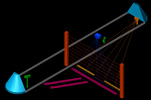Single HOT Lane Combined LPR and AVC System
The TDS design for the combined violation enforcement and vehicle classification system for a HOT lane tightly integrates an LPR camera system with two laser scanners and a quad core processor. This solution provides 100% vehicle image coverage of the roadway including vehicles that are straddling lanes. This is designed to augment the system integrator provided Lane Controller.

Single HOT Lane Layout
A high-resolution rear color camera and associated illuminator is provided for each HOT lane in order to capture images of the vehicles' license number plates passing through the tolling zone. The camera provides a field-of-view that spans an entire lane with 1 foot of overlap on each side, ensuring that an entire plate is captured in at least one image in the case of a vehicle straddling 2 lanes.
The two scanners together provide the ability to:
- Identify the start and end of vehicles.
- Provide a vertical profile of the vehicle.
- Provide the height and width of all four wheel vehicles based on the vertical profile.
- Provide the length of the four wheel vehicle based on continuous lateral scanning of the vehicle as it passes through the profiling zone.
- Identify motorcycles based on width and height of the profile.
- Provide triggering for the camera system.
The proposed design includes an image capture processor assigned to each lane. The Linux based processor will host the TDS License Plate Reader (LPR) software which provides the suite of functions and interfaces involved in controlling the rear camera, performing license plate OCR, and uploading data and images to the Image Server as required. The processor will generate the image capture trigger from the Lane Controller over a dedicated Ethernet subnet, or directly from the TDS AVC application running on the same processor.
The vehicle classification is determined from the data from the two scanners. The scan classes are
- Motorcycles
- Vehicles by Length (Tailored to the Agency Class Table)
The vehicle classification can then be checked by the Lane Controller against the class in the RFID response to determine if the vehicle class matches the tag class. In the event of a mismatch, the vehicle is considered to be a violator and processed as such by the Lane Controller
The TDS OCR algorithm has also undergone years of design enhancements that exploit current state of the art techniques in order to attain high accuracy of converting plate images to alphanumeric representations. The OCR algorithms are very tolerant of plate image axis differentials, partial character occlusion, plate size, and plate design.
Performance Specifications
- 0 to 100 miles per hour with a minimum 4 foot separation.
- Captures two (2) images per vehicle.
- Operates under all lighting conditions.
- The system reports the plate number and state.
- The system is capable of processing 2200 vehicles per hour.
- The system captures motorcycle images.
- The system captures human readable rear license plate images, where both the plate number and the US state of registration are discernible with a success rate of 99% or greater.
Single HOT Lane Traffic Flow



